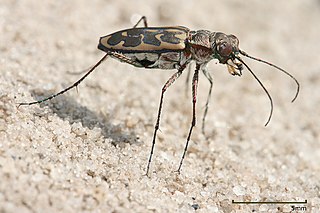
Tiger beetles are a large group of beetles, from the Cicindelinae subfamily, known for their aggressive predatory habits and running speed. The fastest known species of tiger beetle, Cicindela hudsoni, can run at a speed of 9 km/h, or about 125 body lengths per second. As of 2005, about 2,600 species and subspecies were known, with the richest diversity in the Oriental (Indo-Malayan) region, followed by the Neotropics.
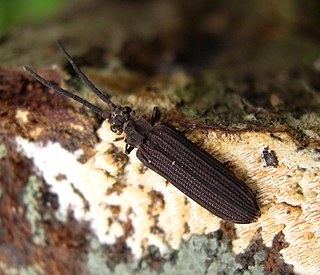
The Archostemata are the smallest suborder of beetles, consisting 45 living species in five families. They are an ancient lineage with a number of primitive characteristics. They are similar in morphology to the first beetles, which appear in the fossil record about 250 million years ago. Antennae may be thread-shaped (filiform) or like a string of beads (moniliform). This suborder also contains the only beetles where both sexes are paedogenic, Micromalthus debilis.

Timarcha is a genus of leaf beetles in the family Chrysomelidae, with more than 100 described species in three subgenera. The most widely known species is T. tenebricosa, the bloody-nosed beetle. All species are black, wingless organisms. Timarcha are herbivorous species, living mostly on plants belonging to Rubiaceae and Plumbaginaceae, although a few can feed on Brassicaceae and Rosaceae.

Chlaenius is a large and diverse genus of ground beetle. It is native to the Palearctic realm, Afrotropical realm, and Nearctic realm. Worldwide, roughly 1,000 species are currently recognized with the majority of known species occurring in the Oriental and Afrotropical regions. The genus is divided into many subgenera.

Ptilinus is a genus of death-watch beetles in the family Ptinidae. It is native to the Palearctic, the Near East, the Nearctic, the Neotropical and North Africa. There are at least nine described species in Ptilinus.

Evodinus borealis is the species of the Lepturinae subfamily in long-horned beetle family. This beetle is ranged from Atlantic coasts through Eurasian continent to Pacific coasts.

Aulonogyrus is a genus of beetles in the family Gyrinidae, containing the following species:
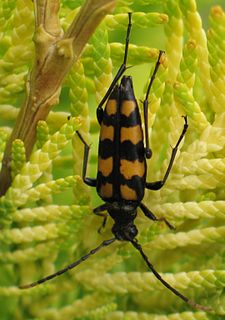
Leptura is a genus of beetles in the family Cerambycidae, containing the following species:

Evodinus is a genus of beetles in the family Cerambycidae, containing the following species:

Stenocorus is a genus of beetles in the family Cerambycidae, containing the following species:
Copelatus monticola is a species of diving beetle. It is part of the genus Copelatus, which is in the subfamily Copelatinae of the family Dytiscidae. It was described by Félix Guignot in 1951.
Evodinus lanhami is a species of beetle in the family Cerambycidae. It was described by Lewis in 1976.
Leptura plebeja is a species of beetle in the family Cerambycidae. It was described by Randall in 1838.
Leptura subhamata is a species of beetle in the family Cerambycidae. It was described by Randall in 1838.
Obereopsis monticola is a species of beetle in the family Cerambycidae. It was described by Hintz in 1919.
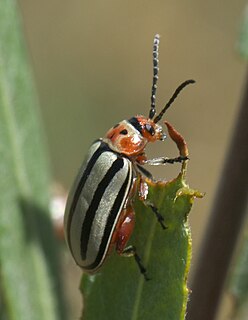
Disonycha is a genus of flea beetles in the family Chrysomelidae. There are at least 30 described species in Disonycha.
Chrysobothris monticola is a species of metallic wood-boring beetle in the family Buprestidae. It is found in North America.

Coccinella monticola, commonly called the mountain lady beetle or Tamarack ladybug, is a species of lady beetle native to the western United States and Canada, south-eastern Canada and New England states.
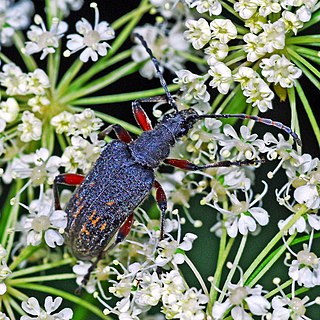
Evodinus clathratus is a species of beetles in the family Cerambycidae.
Scymnus monticola, is a species of beetle found in the family Coccinellidae discovered by Thomas Lincoln Casey Jr. in 1899. It is found in North America.













